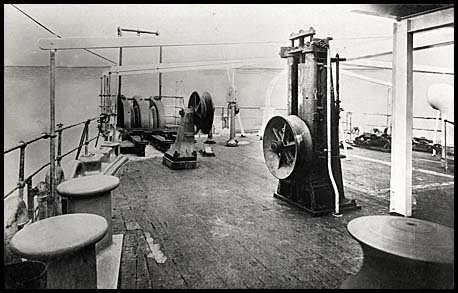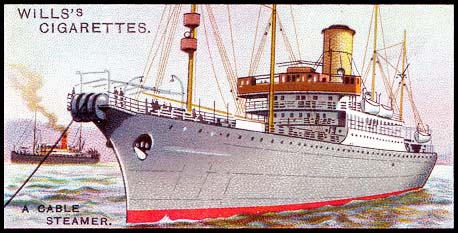Special ships and those operating in Australian/New Zealand/Pacific waters to about 1930.
- Australia 1901-1988
- New South Wales
- Overview of NSW
- Telegraph lines
- Telegraph Offices
- Date stamps
- Forms
- Envelopes
- Instructional annotation
- Collect
- Delayed
- Free
- Immediate Urgent
- Reply paid
- Rates
- Stamps
- 1871 Telegraph stamps
- 1885 proposal
- 1893 proposal
- Queensland
- South Australia
- Tasmania
- Victoria
- Western Australia
- International
- Special aspects
There were a number of ships which were used to lay telegraphic cables to Australia as well as in and around Australian waters and the Pacific. Details and images of some of these are presented below (together with a snapshot of the Great Eastern)..
The cable ships referenced below are:
- C. S. Agnes;
- C. S. Anglia;
- C. S. Colonia;
- C.S. Domina;
- C. S. Edinburgh;
- C. S. Faraday - both ships with this name.
- C. S. François Arago;
- C. S. Hibernia;
- C. S. Investigator;
- C. S. Iris;
- C. S. Kangaroo;
- C.S. Monarch;
- C. S. Patrol;
- C. S. Scotia;
- C. S. Seine;
- C. S. Silvertown;
- H.M.C.S. Victoria;
- S.S. Great Eastern;
|
The Edinburgh was not a large ship - its largest tank being 32 feet in diameter. Cable laying in relation to Australia and the Pacific:
After that, the Edinburgh remained as the repair ship. |
|
The first C. S. Faraday was purpose designed and built for Siemens Bros. to lay the Atlantic cable in 1874 (Rye Beach, New Hampshire, USA - Tor Bay, Nova Scotia - Ballinskelligs, Ireland). She had a length of 360 feet and was of 5,052 gross tons. The two funnels were placed side by side and the bow and stern were of similar design which gave the vessel a unique appearance In 1909, the Faraday laid the Tasmanian cable from Flinders to Port Dalrymple, George Town. This was her only Australian/Pacific/Far East operation.
|
 The first C. S. Faraday. |
The second C. S. Faraday was built in 1922-23 as a replacement for the first. She was 415 feet in length and of 5,622 gross tons. She was owned by Siemens Brothers and retained by them after a merger with the Telegraph Construction and Maintenance Company to form Submarine Cables Ltd.
In 1926, the Faraday laid the duplicate Fanning Island - Fiji cable after which she returned to Sydney for 30 days until the cable was taken over and then loaded general cargo to return to London. This was her only Australian/Pacific/Far East operation. On 25 March 1941, the Faraday received instructions to join a convoy of 25 ships which were due to leave Falmouth for Milford Haven. Due to severe weather, only five ships, including Faraday, sailed but they soon lost contact with each other due to poor visibility. Faraday came under attack at about 7.45 pm from a Heinkel 111 which dropped two bombs and strafed the ship with machine gun fire killing eight of the crew and injuring twenty five. The bombs exploded in the oil bunkers causing a serious fire and the crew abandoned ship which eventually ran aground off St Anne´s Head. The Heinkel was shot down by Faraday´s gunners. The wreck of the Faraday now lies in depths of water between 5 and 16 meters under the cliffs at Hoopers Point, Pembrokeshire. |
 The second C. S. Faraday. |
 The dynamometer and the stern sheaves on the after deck. |
|
The Hibernia was a large ship of 3,000 tons and had three tanks 30 feet in diameter and 26 feet in depth. Each tank held approximately 450 miles of cable. In 1870, the C.S. Hibernia laid the cable from Singapore to Batavia and then, in 1871, both the Hibernia and the C. S. Edinburgh laid the 1,082 nm cable from Banjoewangie to Darwin cable. In 1876, the newly formed Eastern Extension company used both the Hibernia and Edinburgh again to lay the 1,283 nm cable from Sydney to Wellington, New Zealand. An excellent and very complete description of the Hibernia and its role in laying the cable to New Zealand is given elsewhere. In 1877, the Hibernia worked with the C. S. Kangaroo to lay the Burma-Rangoon-Penang cable. |
|
|
The Investigator is a smart looking iron clipper of 700 tons gross and 569 tones register. She was built on the Tyne at Mitchell and Co.'s yard, and is of exceedingly strong proportions, her ribs being only 20 in. apart. The Investigaor measures 204 feet in length with a 28 feet beam and a depth of hold of 16 feet. She is propelled by a screw and her engines, which are on the inverted double acting principle, were made and fitted by T. D. Marshall, of Shields. They are of 160 horse power nominal and in moderate weather the speed attained by the vessel is between seven and eight knots. A greater rate of speed could be accomplished but for the insufficient oiler accommodation. She is also fitted up with steam appatatus for condensing water at the rate of 1200 gallons per diem. The Investigator, when quite a new craft, was purchased by the home Government during the time of the Crimean war to convey railway plant to the scene of operations in the Crimea. Subsequently she was purchased by the Telegraph Construction and Maintenance Company and came to Tasmania under their auspices in 1869 to lay the second Tasmanian-Victorian cable. She was then transferred to the West Indian and Panama Telegraph Company. The Investator was commanded during her Tasmanian visit by Captain D. Cruikshank, a brother of the late Mr. Andrew Rose Cruikshank, who was well known in commercial circles in Tasmania as one of the promoters of the National Bank and a partner in the then firm of Dalgety, Cruikshank. and Co. |
|
In 1871, the C. S. Kangaroo, in concert with the Agnes, Belgian and the Minia laid the important Singapore-Saigon-Hong Kong cable. In 1877, the Kangaroo worked with the C. S. Hibernia to lay the Burma-Rangoon-Penang cable. In 1884, the Kangaroo laid the Tonkin-Hue-Saigon-Hong Kong cable working with the C. S. Calabria. |
|
The first ship permanently fitted out to lay cables. She had been built in 1830 as a paddle-steamer but was outfitted as a cable ship by the Electric Telegraph Company in 1853. There have been five ships named the Monarch. In 1973, the fifth C.S. Monarch was launched. She was broken up in 2003. |
 |
|
The Cocos-Batavia cable was laid in 1908 by C.S. Patrol. |
| C. S. Seine.
The C. S. Seine began cable work in 1873 after servig as a twin funnelled paddle steamer for the Royal Mail on its West Indian routes. She was converted to screw propulsion in 1872. Subsequently, the Seine laid many cables across the world including:
She was finally scapped in 1905. |
 |
| C. S. Silvertown.
In March 1873, the first purpose-built cable-laying ship was built by C. Mitchell & Co of Newcastle-upon-Tyne. She was named the C.S. Hooper and immediately commissioned to lay the Para-Maranham-Ceara-Pernambuco-Bahia-Rio de Janeiro cable for the Western and Brazilian Telegraph Company. She as 338 feet in length and 55 feet in breadth. |
 |
In 1881, the Hooper was renamedPerhaps the new name was not accidental and the sale was already nearing completion. C.S. Silvertown and, in the following year, she was sold to the India Rubber, Gutta Percha and Telegraph Works Ltd. As shown by the receipt, the Gutta Percha Company was based at Silvertown. In 1916, she was purchased by the Anglo-American Oil Company for use as an oil carrier and for bunkering oil. After two other lives, she was sold to Italian shipwreckers in 1935. Cable laying in association with Australia and the Pacific:
|
|
|
|
|
The H.M.C.S. Victoria laid the cable in 1859 from Victoria to Tasmania in conjunction with the Omeo. |
|
Built at the Millwall Iron Works on the River Thames in England. At the time of her lauch in 1858, she was the biggest ship ever built. Her designer I. K. Brunel called her "The Great Babe" - and unfortunately he died soon after her maiden voyage. The "Babe" was converted to a cable ship and laid the first cable (to last) across the Atlantic in 1866. There had been several attempts to lay the cable - in July/August 1865, 1,062 miles oof cable had been laid before the cable snapped near the end of the ship and the cable was lost. The Anglo-American Telegraph Company was then inaugurated to lay a new cable and that task was competed successfully on 27 July 1866 when the cable on the Eastern reached Heart's Content in Newfoundlan. The Great Eastern finished her career as a floating music hall and advertising hoarding in Liverpool. She was broken up in 1889. As Wikipedia notes, there is no foundation for the legend that a phantom riveter had been accidently sealed in the gigantic hull. The top mast was purchased by the Liverpool Football Cub and is used as a flagpole at their Anfield ground alongside Spion Kop. |











